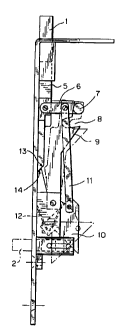Some of the information on this Web page has been provided by external sources. The Government of Canada is not responsible for the accuracy, reliability or currency of the information supplied by external sources. Users wishing to rely upon this information should consult directly with the source of the information. Content provided by external sources is not subject to official languages, privacy and accessibility requirements.
Any discrepancies in the text and image of the Claims and Abstract are due to differing posting times. Text of the Claims and Abstract are posted:
| (12) Patent: | (11) CA 2213208 |
|---|---|
| (54) English Title: | LOCKING DEVICE FOR DOORS |
| (54) French Title: | DISPOSITIF DE VERROUILLAGE DE PORTES |
| Status: | Deemed expired |
| (51) International Patent Classification (IPC): |
|
|---|---|
| (72) Inventors : |
|
| (73) Owners : |
|
| (71) Applicants : |
|
| (74) Agent: | NORTON ROSE FULBRIGHT CANADA LLP/S.E.N.C.R.L., S.R.L. |
| (74) Associate agent: | |
| (45) Issued: | 2006-04-18 |
| (86) PCT Filing Date: | 1996-02-12 |
| (87) Open to Public Inspection: | 1996-08-22 |
| Examination requested: | 2003-02-11 |
| Availability of licence: | N/A |
| (25) Language of filing: | English |
| Patent Cooperation Treaty (PCT): | Yes |
|---|---|
| (86) PCT Filing Number: | PCT/SE1996/000166 |
| (87) International Publication Number: | WO1996/025578 |
| (85) National Entry: | 1997-08-15 |
| (30) Application Priority Data: | ||||||
|---|---|---|---|---|---|---|
|
The present invention relates to a locking device for doors, intended for
connection between
the dead-bolt (1) of the door and the drive means (2) of the lock. The
invention is characterized in
that a hinged arm (6) is connected to the dead-bolt (1) or its extension (5),
a wheel (7) or pin being
arranged at the other end of the arm (6) and designed to tumble into a recess
(8) in a pivotable
cam-disc (9), or to be disengaged from this recess by means of a link
mechanism (11), whereupon
in the latter position the cam-disc (9) is arranged to block the dead-bolt (1)
in the first position
and upon tumbling into the recess (8) to release it, and also that the dead-
bolt (1) has an inclined
surface (3) designed, upon pressure against the dead-bolt, to assist in the
opening process.
L'invention concerne un dispositif de verrouillage de portes conçu pour assurer la liaison entre le pêne dormant (1) de la porte et le moyen de commande (2) du verrou. Elle se caractérise en ce qu'un bras articulé (6) est relié au pêne dormant (1) ou à son extension (5), une roue ou une broche prévue à l'autre extrémité du bras (6) étant conçue pour culbuter dans un évidement (8) situé dans un disque à cames (9) pivotant ou pour être délogée de cet évidement par un mécanisme de liaison (11), le disque à cames (9) étant conçu, dans cette dernière position, pour bloquer le pêne dormant (1) dans la première position et le débloquer lorsqu'il culbute dans l'évidement (8), et en ce que le pêne dormant présente une surface inclinée (3) conçue, lorsqu'une pression est exercée sur ledit pêne dormant, pour faciliter le processus d'ouverture.
Note: Claims are shown in the official language in which they were submitted.
Note: Descriptions are shown in the official language in which they were submitted.

For a clearer understanding of the status of the application/patent presented on this page, the site Disclaimer , as well as the definitions for Patent , Administrative Status , Maintenance Fee and Payment History should be consulted.
| Title | Date |
|---|---|
| Forecasted Issue Date | 2006-04-18 |
| (86) PCT Filing Date | 1996-02-12 |
| (87) PCT Publication Date | 1996-08-22 |
| (85) National Entry | 1997-08-15 |
| Examination Requested | 2003-02-11 |
| (45) Issued | 2006-04-18 |
| Deemed Expired | 2016-02-12 |
There is no abandonment history.
Note: Records showing the ownership history in alphabetical order.
| Current Owners on Record |
|---|
| STENDALS ELEKTRISKA AB |
| Past Owners on Record |
|---|
| STENDAL, JAN |